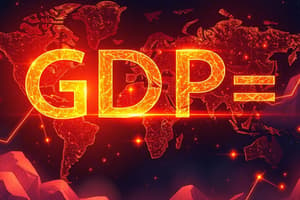Podcast
Questions and Answers
What effect does an increase in the world interest rate have on the supply of Canadian dollars in the foreign-currency exchange market?
What effect does an increase in the world interest rate have on the supply of Canadian dollars in the foreign-currency exchange market?
- It increases the supply of Canadian dollars. (correct)
- It causes the supply to fluctuate unpredictably.
- It has no effect on the supply.
- It decreases the supply of Canadian dollars.
How does an import quota affect net exports at any given real exchange rate?
How does an import quota affect net exports at any given real exchange rate?
- Net exports decrease due to increased imports.
- Net exports remain unchanged.
- Net exports increase due to decreased imports. (correct)
- Net exports are unaffected by changes in imports.
What happens to the real exchange rate when there is a government deficit?
What happens to the real exchange rate when there is a government deficit?
- It increases, leading to a decrease in net exports. (correct)
- It fluctuates randomly without a clear pattern.
- It remains constant regardless of the deficit.
- It decreases, leading to an increase in net exports.
Which factor primarily determines the supply of Canadian dollars in the foreign-currency exchange market?
Which factor primarily determines the supply of Canadian dollars in the foreign-currency exchange market?
What is the effect of capital flight on the peso?
What is the effect of capital flight on the peso?
What does an increase in savings in an economy lead to?
What does an increase in savings in an economy lead to?
What is the primary purpose of a tariff?
What is the primary purpose of a tariff?
What is the relationship between net capital outflow (NCO) and net exports (NX)?
What is the relationship between net capital outflow (NCO) and net exports (NX)?
How does political instability affect the demand for a country's assets?
How does political instability affect the demand for a country's assets?
What is the effect of a higher real exchange rate on exports?
What is the effect of a higher real exchange rate on exports?
How is the interest rate determined in an open economy?
How is the interest rate determined in an open economy?
What does it indicate when borrowing exceeds national savings in the context of loanable funds?
What does it indicate when borrowing exceeds national savings in the context of loanable funds?
If net capital outflow (NCO) is negative, what does this imply?
If net capital outflow (NCO) is negative, what does this imply?
What is the relationship between NCO and net exports (NX) in an economy?
What is the relationship between NCO and net exports (NX) in an economy?
What happens in the foreign-currency exchange market when a Canadian purchases Japanese goods?
What happens in the foreign-currency exchange market when a Canadian purchases Japanese goods?
What is required to purchase goods from foreign sellers?
What is required to purchase goods from foreign sellers?
Which equation reflects the relationship between savings (S), investment (I), and net exports (NX)?
Which equation reflects the relationship between savings (S), investment (I), and net exports (NX)?
What balances the supply and demand for Canadian dollars in the foreign exchange market?
What balances the supply and demand for Canadian dollars in the foreign exchange market?
Flashcards
Interest rate in an open economy
Interest rate in an open economy
In an open economy, the interest rate is set by global financial markets, not just domestic supply and demand.
What is net capital outflow?
What is net capital outflow?
The difference between the quantity of loanable funds supplied (savings) and the quantity demanded (investment) is the net capital outflow (NCO).
What happens when investment exceeds savings in an open economy?
What happens when investment exceeds savings in an open economy?
When a country's investment exceeds its savings, foreigners provide the extra funds, resulting in a negative NCO.
Relationship between NCO and NX
Relationship between NCO and NX
Signup and view all the flashcards
What happens when a Canadian buys goods or assets from abroad?
What happens when a Canadian buys goods or assets from abroad?
Signup and view all the flashcards
What happens when a foreign resident buys Canadian goods or assets?
What happens when a foreign resident buys Canadian goods or assets?
Signup and view all the flashcards
How does net exports (NX) impact the market for foreign currency?
How does net exports (NX) impact the market for foreign currency?
Signup and view all the flashcards
How does net capital outflow (NCO) impact the market for foreign currency?
How does net capital outflow (NCO) impact the market for foreign currency?
Signup and view all the flashcards
Real Exchange Rate (E)
Real Exchange Rate (E)
Signup and view all the flashcards
Net Exports (NX)
Net Exports (NX)
Signup and view all the flashcards
Net Capital Outflow (NCO)
Net Capital Outflow (NCO)
Signup and view all the flashcards
Increase in World Interest Rate
Increase in World Interest Rate
Signup and view all the flashcards
Increase in Government Deficit
Increase in Government Deficit
Signup and view all the flashcards
Binding Import Quota
Binding Import Quota
Signup and view all the flashcards
Capital Flight
Capital Flight
Signup and view all the flashcards
Political Instability and Higher Interest Rates
Political Instability and Higher Interest Rates
Signup and view all the flashcards
Capital Flight and Currency Depreciation
Capital Flight and Currency Depreciation
Signup and view all the flashcards
Increase in Savings and Currency Depreciation
Increase in Savings and Currency Depreciation
Signup and view all the flashcards
Study Notes
Market for Loanable Funds (Open Economy)
- Supply of loanable funds equals investment plus net capital outflow (S = I + NCO)
- Domestic interest rate equals world interest rate (r = rw) in an open economy.
- Market equilibrium is determined by global financial markets, not domestic supply and demand.
- The difference between saving and investment (I – S) equals net capital outflow (NCO).
Equilibrium in the Market for Loanable Funds (Open Economy)
- In an open economy, if investment exceeds saving (I > S), the extra borrowing is filled by foreign saving.
- This results in a negative net capital outflow (NCO), where foreigners buy more domestic assets than domestic residents buy foreign assets.
- Canada has typically had a negative NCO position over the last 60 years.
Net Foreign Investment and the Trade Balance
- Net capital outflow (NCO) equals net exports (NX).
- The market for loanable funds determines the trade balance.
Market for Foreign-Currency Exchange
-
Purchasing foreign goods requires exchanging domestic currency for foreign currency.
-
Savings equal investment plus net exports (S = I + NX).
-
Canadian buying Japanese goods requires supplying Canadian dollars and demanding Japanese yen.
-
Japanese buying Canadian goods requires demanding Canadian dollars and supplying Japanese yen.
-
Net exports determine the net demand for domestic currency.
-
Net capital outflow determines the net supply of domestic currency.
-
The real exchange rate (E) balances supply and demand for the domestic currency in the foreign-currency exchange market.
Equilibrium in the Open Economy
- Equilibrium requires balance in both loanable funds and foreign-currency exchange markets.
- Net capital outflow (NCO) is determined by the supply and demand for loanable funds and affects the real exchange rate.
- NCO can be negative.
Policies and Events in an Open Economy
- Examples include changes in world interest rates and government deficits.
An Increase in the World Interest Rate
- Increased NCO leads to a fall in the real exchange rate (depreciation of the domestic currency).
- Cheaper domestic goods lead to higher exports and lower imports, increasing net exports (NX).
Increase in Government Deficit
- Reduced national saving.
- Lower NCO results in an appreciation of the domestic currency and reduced net exports (NX).
- Government deficits do not crowd out investment in an open economy; instead they crowd out net exports.
Trade Policy
- Trade policy (e.g., tariffs, quotas) directly affects imports and exports.
How Does an Import Quota Affect the Trade Balance?
- A binding import quota reduces imports.
- At any real exchange rate, net exports rise; demand for currency rises as well.
- No change in supply of currency, only higher real exchange rate leading to reduced exports, offsetting increased imports. Trade volume decreases. The trade balance is unchanged.
Political Instability and Capital Flight
- Capital flight is a sudden reduction in demand for a country's assets.
- This leads to higher domestic interest rates to compensate for the greater risk of default.
- NCO increases, domestic currency depreciates.
Further Effects of an Increase in Saving
- An increase in savings leads to higher NCO, which decreases the real exchange rate and increases net exports.
Studying That Suits You
Use AI to generate personalized quizzes and flashcards to suit your learning preferences.




